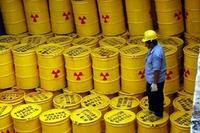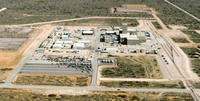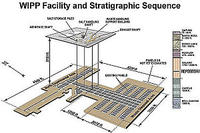-
Using cosmic rays to peer inside Fukushima Daiichi reactors
Muon radiography (also called cosmic-ray radiography) uses secondary particles generated when cosmic rays collide with upper regions of Earth’s atmosphere to create images of the objects that the particles, called muons, penetrate. The process is analogous to an X-ray image, except muons are produced naturally and do not damage the materials they contact. Los Alamos National Laboratory the other day announced an impending partnership with Toshiba Corporation to use muon tomography safely to peer inside the cores of the Fukushima Daiichi reactors and create high-resolution images of the damaged nuclear material inside without ever breaching the cores themselves. The initiative could reduce the time required to clean up the disabled complex by at least a decade and greatly reduce radiation exposure to personnel working at the plant.
-
-
Urgent need: Dirty bomb detection technology which does not rely on helium
It has taken 4.7 billion years for Earth to accumulate our helium reserves, but these reserves are dwindling at an alarming rate, and will be exhausted by around 2025. The supplies we have originated in the very slow radioactive alpha decay that occurs in rocks, and there is no chemical way to manufacture helium. The Department of Defense and other agencies use Helium-3 (He-3) to detect neutrons emanating from Special Nuclear Material (SNM) in order to counter the threat of nuclear-fueled explosives such as dirty bombs. Since the supply of He-3 is rapidly drying up, the Defense Threat Reduction Agency (DTRA) awarded a $2.8 million contract to Alion Science and Technology to develop a replacement technology which will detect neutrons without relying on He-3.
-
-
Pressure grows for building a centralized nuclear waste repository
In 2010, after $9 billion and twenty-five years of construction, the Obama administration pulled the plug on the Yucca Mountain centralized nuclear waste repository. Toxic nuclear waste continues to accumulate on the grounds of U.S. nuclear power plants, with concerns growing about the security of keeping so may tons of such toxic materials in such a dispersed manner. Concerns have been heightened lately by the wave of closing, for economic reasons, of nuclear power plants, and worries about the safety of radioactive waste remaining behind on the grounds of shuttered plants. Senate Bill 1240 calls for the development of a Nuclear Waste Administrationto take responsibility for transporting and storing nuclear waste, and find the right geological location for a new centralized repository.
-
-
Cracked lid of a nuclear waste container may be source of WIPP radiation leak
The radiation leak at the Waste Isolation Pilot Plant (WIPP) near Carlsbad, New Mexico has been linked to a waste container shipped from Los Alamos National Laboratory (LANL), raising questions about the safety of other containers stored at the lab’s northern New Mexico facility and at the Waste Control Specialists (WCS) site in Andrews, Texas.As a precautionary measure, LANL has been ordered to remove thousands of similar containers filled with toxic waste from outdoor storage. Critics of nuclear waste storage practices have blamed the recent radiation accidents on a diminishing culture of safety at the fifteen-year-old WIPP.
-
-
Cesium chloride blood irradiators increase dirty bomb risk
Federal officials want to halt the use of blood irradiators used by hospitals and blood centers to ensure that blood is properly treated before transfusions occur. The irradiation devices contain cesium chloride, a highly radioactive powder which terrorists could use to make a dirty bomb. A 2008 reportby the National Academy of Sciences recommended stopping the licensing of new cesium chloride radiation sources, thereby encouraging the adoption of alternative sources with a less dispersible form of radioactive cesium, including cobalt-60 or X-ray irradiators.
-
-
Safety of nuclear waste storage questioned

The aftermath of the Hiroshima and Nagasaki bombings, and the Chernobyl accident, offers proof that high doses of radiation can have pernicious effects on plant and animal life. The largest human-made radiation risk, however, lies in nuclear waste stored near reactors or in underground repositories like the Waste Isolation Pilot Plant(WIPP) in Carlsbad, New Mexico.
-
-
New Mexico demands clarifications, reassurances on WIPP radiation leaks

New Mexico’s environment secretary Ryan Flynn has ordered the Department of Energy (DOE) to explain how it will protect public health and the environment while it investigates a radiation leak at the underground Waste Isolation Pilot Plant (WIPP). The plant has not been in compliance with various permit requirements since the February underground fire and radiation leak, which eventually led to a plant shutdown.
-
-
Lawmakers want safer waste storage at nuclear plants
Lawmakers on Tuesday introduced a set of bills aimed at improving the safety and security of nuclear power plants’ waste in the event of a natural disaster or terrorism. One of the bills would require nuclear power plant operators to accelerate the transfer of nuclear waste stored in spent fuel pools into dry cask storage units. Current Nuclear Regulatory Commission(NRC) regulations allow spent fuel to remain in spent fuel pools until the reactor completes decommissioning, which can take as long as sixty years. Another bill would stop the NRC from issuing exemptions to its emergency response and security requirements for reactors that have been permanently decommissioned.
-
-
Leaders of Chinese city delay alerting residents to deadly radiation risk
Authorities in the East China city of Nanjing delayed,for thirty-six hours, notifying residents about the loss of deadly isotope iridium-192 pellets at a local industrial plant. The pellets disappeared on Wednesday, and plant officials informed government authorities on Thursday – but did not inform city residents until Saturday. The extremely toxic pellets, the size of beans, were found the following Saturday in an open field one kilometer from the plant. The plant management detained four employees at the plant on Sunday for violating radioactive work regulations and storage rules, and they are likely to face criminal charges.The plant is using the isotope to find flaws in metal components.
-
-
Detecting and defeating radiological threats
Brookhaven National Laboratory’s Radiological Assistance Program (RAP) team works to stay ahead of any radiological threats by using many detection tools that have become increasingly sophisticated and user-friendly. During a deployment, researchers and technicians with backgrounds in various aspects of radiological controls and analysis conduct field monitoring and environmental sampling, assessment, and documentation activities to help decision makers choose appropriate protective actions for the safety of both the public and first responders.
-
-
New detection technology to help combat nuclear trafficking
According to the International Atomic Energy Agency (IAEA), the greatest danger to nuclear security comes from terrorists acquiring sufficient quantities of plutonium or highly enriched uranium (HEU) to construct a crude nuclear explosive device. The IAEA also notes that most cases of illicit nuclear trafficking have involved gram-level quantities, which can be challenging to detect with most inspection methods. Special algorithm coupled with commercial X-ray scanners allows detection of small amounts of fissile materials in luggage.
-
-
New consortium dedicated to developing nuclear arms control verification technologies
A consortium of thirteen universities and eight national laboratories, led by the University of Michigan and including the Los Alamos National Laboratory as a partner, has been awarded a $25 million grant by the NNSA. The consortium is dedicated to the research and development (R&D) of nuclear arms control verification technologies, including nuclear safeguards effectiveness.
-
-
New group formed to monitor Savannah River Site, nuclear waste issues in SE U.S.
Savannah River Site Watch (SRS Watch), a new public-interest watchdog group, was launched last week in what it said was a response to the need for increased monitoring of the nuclear projects carried out by the U.S. Department of Energy (DOE). The group says it has been formed to focus on an array of nuclear projects now underway at Savannah River Site (SRS), the sprawling 310-square mile complex located near Aiken, South Carolina.
-
-
Los Alamos National Lab resumes transuranic waste shipments

The waste was received at Waste Control Specialists in Andrews, Texas, where it will be temporarily staged until it can be shipped to the Waste Isolation Pilot Plant (WIPP) near Carlsbad, New Mexico for final disposal. WIPP has been closed since mid-February as a result of radiation leaks in underground storage tunnels. The shipments keep LANL on track to complete 3,706 Campaign on schedule. The campaign aims to remove 3,706 cubic meters of nuclear waste from LANL by 30 June 2014.
-
-
New center will work to improve methods to detect, prevent the spread of nuclear weapons
The National Nuclear Security Administration (NNSA) has awarded the University of Michigan $25 million to establish the Center for Verification Technology. A team from thirteen universities will work with eight national labs to analyze nuclear nonproliferation efforts, improve technologies for monitoring weapons-grade materials and detecting secret weapon tests, and train the next generation of nonproliferation experts.
-
- All
- Regional
- Water
- Biometrics
- Borders/Immig
- Business
- Cybersecurity
- Detection
- Disasters
- Government
- Infrastructure
- International
- Public health
- Public Safety
- Communication interoperabillity
- Emergency services
- Emergency medical services
- Fire
- First response
- IEDs
- Law Enforcement
- Law Enforcement Technology
- Military technology
- Nonlethal weapons
- Nuclear weapons
- Personal protection equipment
- Police
- Notification /alert systems
- Situational awareness
- Weapons systems
- Sci-Tech
- Sector Reports
- Surveillance
- Transportation
Advertising & Marketing: advertise@newswirepubs.com
Editorial: editor@newswirepubs.com
General: info@newswirepubs.com
2010-2011 © News Wire Publications, LLC News Wire Publications, LLC
220 Old Country Road | Suite 200 | Mineola | New York | 11501
Permissions and Policies
Editorial: editor@newswirepubs.com
General: info@newswirepubs.com
2010-2011 © News Wire Publications, LLC News Wire Publications, LLC
220 Old Country Road | Suite 200 | Mineola | New York | 11501
Permissions and Policies
